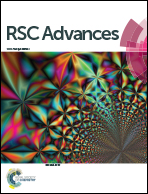Novel mono-cationic fluorescent probes based on different central π-conjugated bridges for two-photon bioimaging of cellular nuclei†
Abstract
A series of novel pyridine mono-cationic two-photon fluorescent probes based on different central π-conjugated bridges, fluorenone (W-pyI), dibenzothiophene (S-pyI), and dibenzofuran (F-pyI), were prepared and studied. Under one-photon excitation in a N,N-dimethylformamide solution, W-pyI, S-pyI, and F-pyI displayed fluorescence quantum yields of 0.401, 0.425, and 0.09, respectively. The two-photon fluorescence performance indicated that these probes possessed two-photon absorption cross-sections of 681 GM (W-pyI), 630 GM (S-pyI), and 620 GM (F-pyI) at 800 nm femtosecond laser excitation. The luminance “turn-on” effect of W-pyI, S-pyI, and F-pyI bonding with calf thymus DNA in Tris–HCl buffer solutions displayed 58-fold, 30-fold, and 25-fold fluorescence quantum yield increments, respectively, and 350–450% two-photon absorption cross-section enhancement. The confocal fluorescence imaging showed clear one- and two-photon fluorescence imaging. The mean co-localization coefficients between these probes and Hoechst 33342 in 3T3 cells ranged from 0.89–0.92, indicating that they showed excellent nuclear targeting abilities. The counterstaining experiments showed these probes possessed good counterstaining compatibility and membrane permeability in the application of multicolor targeting. A time-dependent fluorescence intensity test under continuous femtosecond laser irradiation showed that W-pyI possessed a longer observation time (3000 seconds) and a lower fluorescence attenuation amplitude (7.1%) in the first 300 seconds than S-pyI, F-pyI and other previously reported pyridinium derivatives, demonstrating that the central π-conjugated bridge “fluorenone” played a key role in improving photostability during probe designing for two-photon bioimaging applications.


 Please wait while we load your content...
Please wait while we load your content...